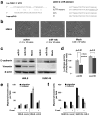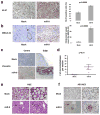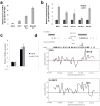miR-9, a MYC/MYCN-activated microRNA, regulates E-cadherin and cancer metastasis
- PMID: 20173740
- PMCID: PMC2845545
- DOI: 10.1038/ncb2024
miR-9, a MYC/MYCN-activated microRNA, regulates E-cadherin and cancer metastasis
Abstract
MicroRNAs (miRNAs) are increasingly implicated in regulating the malignant progression of cancer. Here we show that miR-9, which is upregulated in breast cancer cells, directly targets CDH1, the E-cadherin-encoding messenger RNA, leading to increased cell motility and invasiveness. miR-9-mediated E-cadherin downregulation results in the activation of beta-catenin signalling, which contributes to upregulated expression of the gene encoding vascular endothelial growth factor (VEGF); this leads, in turn, to increased tumour angiogenesis. Overexpression of miR-9 in otherwise non-metastatic breast tumour cells enables these cells to form pulmonary micrometastases in mice. Conversely, inhibiting miR-9 by using a 'miRNA sponge' in highly malignant cells inhibits metastasis formation. Expression of miR-9 is activated by MYC and MYCN, both of which directly bind to the mir-9-3 locus. Significantly, in human cancers, miR-9 levels correlate with MYCN amplification, tumour grade and metastatic status. These findings uncover a regulatory and signalling pathway involving a metastasis-promoting miRNA that is predicted to directly target expression of the key metastasis-suppressing protein E-cadherin.
Conflict of interest statement
The authors declare no competing financial interests.
Figures






Comment in
-
Myc-modulated miR-9 makes more metastases.Nat Cell Biol. 2010 Mar;12(3):209-11. doi: 10.1038/ncb0310-209. Epub 2010 Feb 21. Nat Cell Biol. 2010. PMID: 20173743
Similar articles
-
Myc-modulated miR-9 makes more metastases.Nat Cell Biol. 2010 Mar;12(3):209-11. doi: 10.1038/ncb0310-209. Epub 2010 Feb 21. Nat Cell Biol. 2010. PMID: 20173743
-
MYCN and MYC regulate tumor proliferation and tumorigenesis directly through BMI1 in human neuroblastomas.FASEB J. 2011 Dec;25(12):4138-49. doi: 10.1096/fj.11-185033. Epub 2011 Aug 19. FASEB J. 2011. PMID: 21856782 Free PMC article.
-
MicroRNA-506 inhibits tumor growth and metastasis in nasopharyngeal carcinoma through the inactivation of the Wnt/β-catenin signaling pathway by down-regulating LHX2.J Exp Clin Cancer Res. 2019 Feb 21;38(1):97. doi: 10.1186/s13046-019-1023-4. J Exp Clin Cancer Res. 2019. Retraction in: J Exp Clin Cancer Res. 2021 Sep 30;40(1):309. doi: 10.1186/s13046-021-02113-3. PMID: 30791932 Free PMC article. Retracted. Clinical Trial.
-
MicroRNA involvement in the pathogenesis of neuroblastoma: potential for microRNA mediated therapeutics.Curr Pharm Des. 2009;15(4):456-62. doi: 10.2174/138161209787315837. Curr Pharm Des. 2009. PMID: 19199973 Free PMC article. Review.
-
MYCN, neuroblastoma and focal adhesion kinase (FAK).Front Biosci (Elite Ed). 2011 Jan 1;3(2):421-33. doi: 10.2741/e257. Front Biosci (Elite Ed). 2011. PMID: 21196322 Free PMC article. Review.
Cited by
-
The CREB-miR-9 negative feedback minicircuitry coordinates the migration and proliferation of glioma cells.PLoS One. 2012;7(11):e49570. doi: 10.1371/journal.pone.0049570. Epub 2012 Nov 20. PLoS One. 2012. PMID: 23185366 Free PMC article.
-
Evolution and dynamics of pancreatic cancer progression.Oncogene. 2013 Nov 7;32(45):5253-60. doi: 10.1038/onc.2013.29. Epub 2013 Feb 18. Oncogene. 2013. PMID: 23416985 Free PMC article. Review.
-
Pancreatic cancer stem cell markers and exosomes - the incentive push.World J Gastroenterol. 2016 Jul 14;22(26):5971-6007. doi: 10.3748/wjg.v22.i26.5971. World J Gastroenterol. 2016. PMID: 27468191 Free PMC article. Review.
-
A statin-regulated microRNA represses human c-Myc expression and function.EMBO Mol Med. 2012 Sep;4(9):896-909. doi: 10.1002/emmm.201101045. Epub 2012 Aug 7. EMBO Mol Med. 2012. PMID: 22887866 Free PMC article.
-
MicroRNA-584 functions as a tumor suppressor and targets PTTG1IP in glioma.Int J Clin Exp Pathol. 2014 Dec 1;7(12):8573-82. eCollection 2014. Int J Clin Exp Pathol. 2014. PMID: 25674221 Free PMC article.
References
-
- Fidler IJ. The pathogenesis of cancer metastasis: the ‘seed and soil’ hypothesis revisited. Nat Rev Cancer. 2003;3:453–8. - PubMed
-
- Thiery JP. Epithelial-mesenchymal transitions in tumour progression. Nat Rev Cancer. 2002;2:442–54. - PubMed
-
- Nicoloso MS, Spizzo R, Shimizu M, Rossi S, Calin GA. MicroRNAs--the micro steering wheel of tumour metastases. Nat Rev Cancer. 2009;9:293–302. - PubMed
-
- Ma L, Weinberg RA. Micromanagers of malignancy: role of microRNAs in regulating metastasis. Trends Genet. 2008;24:448–56. - PubMed
-
- Bartel DP. MicroRNAs: genomics, biogenesis, mechanism, and function. Cell. 2004;116:281–97. - PubMed
Publication types
MeSH terms
Substances
Grants and funding
LinkOut - more resources
Full Text Sources
Other Literature Sources
Medical
Research Materials
Miscellaneous

